Posts filed under 'The Daring Bakers Challenges'
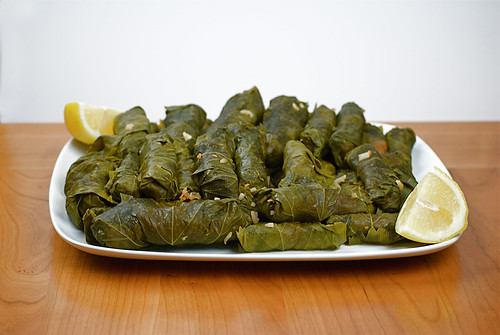

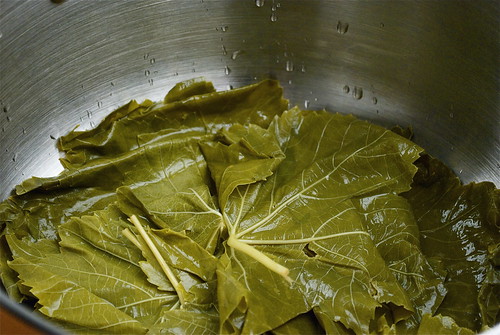
This is a recipe that I have wanted to make and post on here for ages…but every time I have made them, I have either forgotten to photograph them, or not had a working camera.
Anyway, these are my Grama Sanom’s grapeleaves! FINALLY!
So there really isn’t one particular story to go with this dish. There were many stories over many years, that I hold close to my heart, and remember every time I make these. Because, whenever I saw my Grama Sanom, we would 9 times out of 10 make grapeleaves together. So this is a recipe that I remember very well. And, as the years go by without my dear Grama, I find that little pieces of her live on in me. For instance, when I look down at my hands rolling these leaves, I notice that they are indeed so very like my grandmother’s hands. And in 50 years, I can see them curling into little arthritic cups…just like hers. A painful, but perfect measuring device. 🙂
Some fond memories I have regarding grapeleaves, were things like driving along in the car with my Grama and Jiddu (Jiddu = Grandpa in Arabic), and hearing my Grama shout to my Jiddu to “Pa! Stop the car!”, and we would come to screeching halt at the side of the road, when my Grama would then calmly get out, walk to the side of the road, and start picking grapeleaves off of the vines growing on the side of the road. I would jump out and help her, knowing that my belly would soon be filled with delicious stuffed grapeleaves.
When we would get home, my grama would wash the leaves in cold water removing all the dirt and any stray bugs that may have made their way home with us. After the leaves were rinsed, it was my job to lay all the leaves out so that the veins were facing up, and trim off all the stems while my Grama made the stuffing. (Recipe below). After all the leaves were stacked, vein sides up, and stems cut off, my grama would lay them in a 9×13 baking dish and pour boiling hot water over them until they were covered with it. She would wait until they became their signature dark green color, and were wilted and pliable enough to roll. After they were tender enough, she would drain out all the water and then it was my job to pat them all somewhat dry so they weren’t dripping wet.
Once the leaves were ready, and the meat/rice mixture was ready, it was time to roll! We would sit at the kitchen table for what seemed like hours, and carefully roll out each delicious package. Stacking them up into a big pot. When they were done, she would mix up a bowl of water and tomato paste, stirring it until the paste had fully dissolved. She would then place a plate upside down over the pot of leaves, and pour the tomato mixture over the leaves until the leaves were just covered. She would throw in a few teaspoons of salt, and a little squeeze of lemon…and in around 30 minutes…we would be enjoying our grapeleaves feast.
Let me just say, that I have eaten my fair share of grapeleaves at restaurants over the years, and never have any of them come close to these. Maybe it’s just because the way she made them, was what I became accustomed to, what I grew up eating…but to me, they are even more delicious because they are wrapped up in my memories of her. And so whenever I make them, I look down at my hands…and know she is with me and somewhere up there, smiling down on me for keeping her memory and traditions going. I can’t wait to have kids and grandkids so that I can share this tradition with them.
In the meantime, I am sharing it with you! So please enjoy them!
Grapeleaves
Recipe from Mary Sanom
2 lbs. ground chuck (you can also use ground turkey, but if you do I like to add a little olive oil for some fat)
1 lb. long grain white rice
1 small onion (finely diced)
1 small green pepper (finely diced)
1 clove minced garlic
8 oz tomato sauce
8 oz tomato sauce or paste
Salt/Pepper to taste
Grapeleaves (from the side of the road! OR you can buy them in the jar at the grocery store in the ethnic food aisle, but they aren’t as tender as fresh picked!*)
1 lemon
Instructions:
- Mix ground chuck, rice, onion, green pepper, garlic and tomato sauce in large bowl. Season to taste with salt and pepper. (I use around a teaspoon, perhaps a little more). I usually just take a little bite of this mixture to make sure it is seasoned correctly, which freaks a lot of people out to eat raw meat, but I’ve been doing it all my life, and never once have I fallen ill from this. 😉
- Pour in some tomato sauce enough to moisten the meat. You want the meat mixture to be slightly moist, but not so it’s so wet that it’s falling apart
- Place enough grapeleaves in the bottom of a large pot to cover the bottom of the pot. This will keep the grapeleaves from sticking to the bottom of the pot and burning.
- Lay out a grapeleaf with the vein side up. Place a small amount of the beef and rice at the bottom 1/3 of the leaf (see photo above), tuck in the sides of the leaves over the meat, and begin to roll up like a cigar
- Continue rolling your grapeleaves, and laying them in rows on the bottom of the pot, which has been lined with unfilled leaves. When your first layer of grapeleaves has lined the bottom of the pot, you want to start the new layer in the opposite direction, so that the rows criss-cross each other. This will allow the liquid to get to all the leaves easier than it would if they were all going the same direction and packed in tightly together
- Keep rolling up all your leaves, and stacking the layers, until there are no more leaves/or no more filling/or your pot is full! I never like to fill the pot more than 3/4 with grapeleaves to allow room for the liquid, the plate, and for the liquid to boil and bubble up over the leaves without spilling out of the pot
- Once you’ve got your leaves all rolled, place a plate upside down over the leaves. This will keep the leaves from floating during cooking, and coming unrolled.
- In the bowl that your meat mixture was in, scoop out a 8 oz can of tomato paste and mix with enough water to cover your grapeleaves
- Pour the tomato/water mixture over your leaves until they are just covered.
- Add a teaspoon or so of salt, and a squeeze of half a lemon into the pot
- Cover the pot with a lid, and bring the leaves and liquid to a boil, then reduce heat to medium, and let cook for about 30 minutes or until meat is cooked thru and rice and leaves are tender (if you have a lot of leaves, this may take longer – to test, just take out a leave from the top of the pot and taste it)
- Once your leaves are cooked, remove from heat. Take out the plate, and start removing your grapeleaves with a pair of tongs, arranging them on a pretty serving platter!
- DIG IN! They will be super tender and moist and full of flavor.
- I like to reserve the rest of the sauce from the pot, and use a little bit of it to pour over leftover leaves before I reheat them in the microwave
I hope you enjoy my Grama Sanom’s recipe for Syrian grapeleaves!
Click here to see the whole photo set on my flickr!
*If you do buy grapeleaves from the jar, make sure that you rinse them thoroughly and pat them dry. Also, you CAN freeze fresh grapeleaves, but only after they have been wilted with boiling water, just pat them dry and put stacks of them into ziplock bags and throw them in the freezer. These will last you through the winter months, when you can’t pick them. The best time to pick grapeleaves in Michigan is during July, early August, when they are big enough, but haven’t been eaten by all the bugs.
February 3rd, 2011
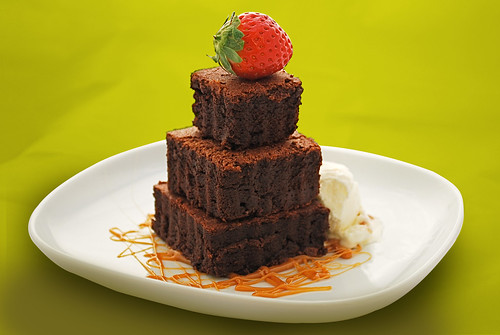
Happy Valentine’s Day!
The February 2009 challenge is hosted by Wendy of WMPE’s blog and Dharm of Dad ~ Baker & Chef. We have chosen a Chocolate Valentino cake by Chef Wan; a Vanilla Ice Cream recipe from Dharm and a Vanilla Ice Cream recipe from Wendy as the challenge.
This month’s challenge was super quick and easy. I kept things simple and just garnished the cake and ice cream with a strawberry, and melted caramel. This cake was DELICIOUS. I would highly recommend this is you are strapped for cash and time. With only three ingredients, it was inexpensive, but tasted ridiculously rich and decadent. YUM!!!

Enjoy the recipes below!
Chocolate Valentino
Preparation Time: 20 minutes
16 ounces (1 pound) (454 grams) of semisweet chocolate, roughly chopped
½ cup (1 stick) plus 2 tablespoons (146 grams total) of unsalted butter
5 large eggs separated
1. Put chocolate and butter in a heatproof bowl and set over a pan of simmering water (the bottom of the bowl should not touch the water) and melt, stirring often.
2. While your chocolate butter mixture is cooling. Butter your pan and line with a parchment circle then butter the parchment.
3. Separate the egg yolks from the egg whites and put into two medium/large bowls.
4. Whip the egg whites in a medium/large grease free bowl until stiff peaks are formed (do not over-whip or the cake will be dry).
5. With the same beater beat the egg yolks together.
6. Add the egg yolks to the cooled chocolate.
7. Fold in 1/3 of the egg whites into the chocolate mixture and follow with remaining 2/3rds. Fold until no white remains without deflating the batter. {link of folding demonstration}
8. Pour batter into prepared pan, the batter should fill the pan 3/4 of the way full, and bake at 375F/190C
9. Bake for 25 minutes until an instant read thermometer reads 140F/60C.
Note – If you do not have an instant read thermometer, the top of the cake will look similar to a brownie and a cake tester will appear wet.
10. Cool cake on a rack for 10 minutes then unmold.
Dharm’s Ice Cream Recipe – Classic Vanilla Ice Cream
Preparation Time: 30 minutes
Recipe comes from the Ice Cream Book by Joanna Farrow and Sara Lewis (tested modifications and notes in parentheses by Dharm)
Ingredients
1 Vanilla Pod (or substitute with vanilla extract)
300ml / ½ pint / 1 ¼ cups Semi Skimmed Milk – in the U.S. this is 2% fat (or use fresh full fat milk that is pasteurised and homogenised {as opposed to canned or powdered}). Dharm used whole milk.
4 large egg yolks
75g / 3oz / 6 tbsp caster sugar {superfine sugar can be achieved in a food processor or use regular granulated sugar}
5ml / 1 tsp corn flour {cornstarch}
300ml / ½ pint / 1 ¼ cups Double Cream (48% butter fat) {in the U.S. heavy cream is 37% fat)
{you can easily increase your cream’s fat content by heating 1/4 cup of heavy cream with 3 Tbs of butter until melted – cool to room temperature and add to the heavy cream as soon as whisk marks appear in the cream, in a slow steady stream, with the mixer on low speed. Raise speed and continue whipping the cream) or use heavy cream the difference will be in the creaminess of the ice cream.
1. Using a small knife slit the vanilla pod lengthways. Pour the milk into a heavy based saucepan, add the vanilla pod and bring to the boil. Remove from heat and leave for 15 minutes to allow the flavours to infuse
Lift the vanilla pod up. Holding it over the pan, scrape the black seeds out of the pod with a small knife so that they fall back into the milk. SET the vanilla pod aside and bring the milk back to the boil.
2. Whisk the egg yolks, sugar and corn-flour in a bowl until the mixture is thick and foamy. 3. Gradually pour in the hot milk, whisking constantly. Return the mixture to the pan and cook over a gentle hear, stirring all the time
4. When the custard thickens and is smooth, pour it back into the bowl. Cool it then chill.
5. By Hand: Whip the cream until it has thickened but still falls from a spoon. Fold it into the custard and pour into a plastic tub or similar freeze-proof container. Freeze for 6 hours or until firm enough to scoop, beating it twice (during the freezing process – to get smoother ice cream or else the ice cream will be icy and coarse)
By Using and Ice Cream Maker: Stir the cream into the custard and churn the mixture until thick (follow instructions on your ice cream maker)

February 28th, 2009
This month’s challenge is brought to us by Karen of Bake My Day and Zorra of 1x umruehren bitte aka Kochtopf. They have chosen Tuiles from The Chocolate Book by Angélique Schmeink and Nougatine and Chocolate Tuiles from Michel Roux.

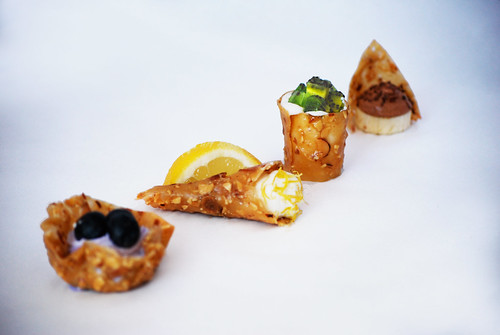

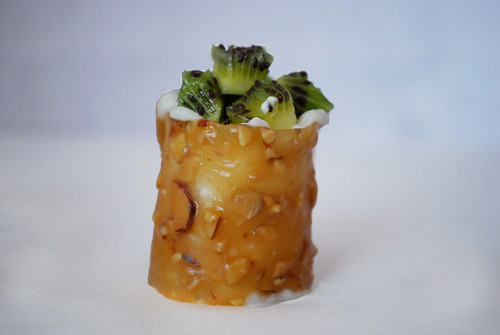
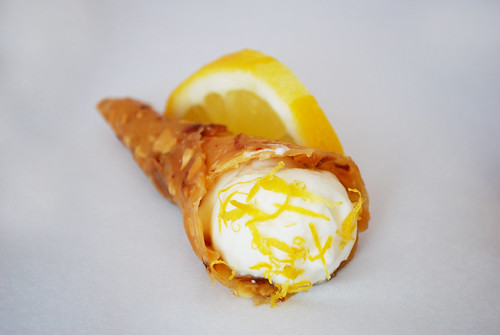

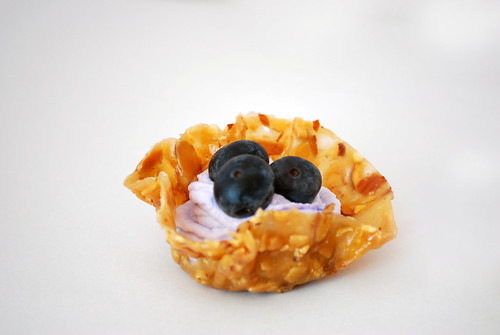
I was SO excited to create these yummy little tuile treats for my very first Daring Baker’s Challenge! It was a super fun challenge, and created a HUGE mess in my kitchen, and burnt my finger really super bad on the sugar, but well worth it at the end of the day. I’m a couple days late in posting this, because work was caarrrrrrrrazy this week….but I finally got to it, and hope you all enjoy it. Please find the recipe for the Nougatine Tuiles below.
I made four different “shapes” for my tuiles…and accompanied them with four slightly different variations on a theme. I did a flavored mousse for each shape. The little cup was filled with a blueberry mousse, and topped with fresh blueberries…MMMmmm! The cone shape was filled with a lemon mousse, and topped with some fresh lemon zest, and garnished with a slice of lemon. The circle ring shape was filled with a white chocolate mousse and topped with some fresh diced kiwi. And finally, the little triangle tuile was accompanied by a slice of banana, topped with a chocolate mousse and some bittersweet chocolate shavings. YUM! YUM!
Nougatine:
From Michel Roux: Finest Desserts
5.1/4 cups / 500 grams sliced almonds
(or 4.1/3 cups/500 grams slivered almonds)
3.1/3 cups / 660 grams sugar
4 tbs / 60 grams butter (optional)
2 tbs oil (vegetable, sunflower, peanut)
Makes 2.3/4 lbs/1.2 kgs! (This is the yield of the recipe given in the book, feel free to downsize!)
Preparation time: 25 minutes
Preheat oven: 180C/350F
Spread the almonds on a baking sheet and toast in the oven until lightly browned. Cook the sugar in a heavy based saucepan over low heat, stirring gently and continuously with a spatula, until it melts to a light golden caramel. Add the almonds and stir over low heat for 1 minute, then stir in the butter until completely absorbed. (This is not essential, but will give the nougat an added sheen) Pour the nougatine onto an oiled baking sheet.
Shaping: place a bakingsheet toward the front of the warm oven, leaving the door half open. The warmth will keep the cookies malleable. Work with one piece at a time, of a size appropriate to the shape you want. Roll out each piece on a warm, lightly oiled baking sheet or lightly oiled marbled surface. It is essential to work quickly, since the nougatine rapidly becomes brittle. Heat the nougatine in a microwave oven for a few seconds only to soften it if needed.
Roll the nougatine into the appropriate thickness for your desired shape, but never thicker than 1/8 inch or 3 mm. Quickly cut out your chosen shapes using cookie cutters, or the blade or heel of a chef’s knife. To mold the nougatine, drape it very rapidly over the mold so that it follows the shape and contours. Leave until completely cold before removing from the mold.
Or, cut out and using your fingers or a knife, push into folds or pleats… use as a basket, twirl round a knitting needle..
Nougatine based shapes can be made two or three days in advance, Keep them in a very dry place and do not fill with something like a mousse more than 2 hours prior to serving.

Thanks so much to Lisa and Ivonne over at the Daring Bakers for giving me such a cool and fun opportunity to join the ranks! 🙂
February 1st, 2009












